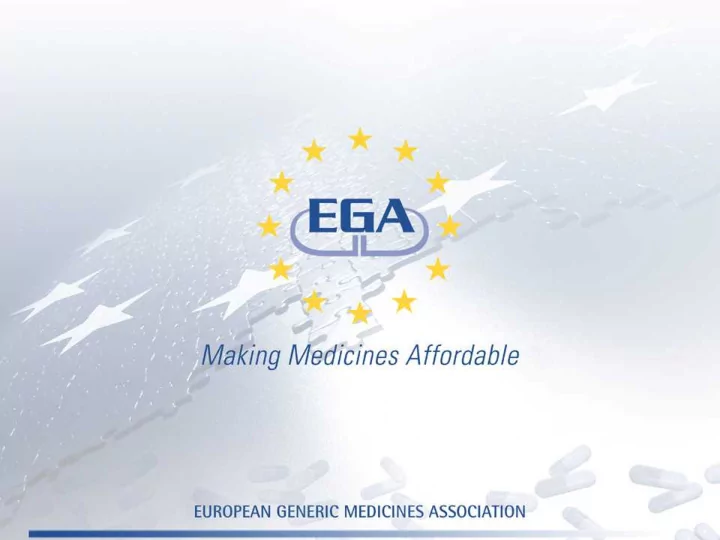

Guideline on Biosimilar Monoclonal Antibodies Non-clinical issues A risk-based approach - rationale and decision points Closed Workshop on biosimilar monoclonal antibodies and immunogenicity of monoclonal antibodies EMA, London, 24 th Oct 2011 Karl Heinz Emmert Head Biosimilar Development, Teva Vice-Chair of EBG
EBG position No compromises in patient safety and integrity are acceptable. Animal studies should be minimised to the extend they are capable to demonstrate similarity or to detect “dissimilarities” between the biosimilar and the reference product. In vitro assays are more sensitive to detect differences than animal studies. Both, the reference antibodies and their biosimilar counterparts are genetically engineered, and carefully designed molecules. Provided comparability has been demonstrated in state-of-the-art comprehensive analytical testing and appropriate in vitro non- clinical assays, animal studies are extremely unlikely to detect any difference between the biosimilar and the reference product. The non-clinical program should be based on an evaluation of the specific risks on a case-by-case basis. 3
Rationale for a risk-based approach Genetically engineered innovative mAbs - the reference mAbs - are carefully designed molecules The Fab-region is designed to selectively interact with the target antigen. The Fc-region is designed to provide a specific mode of action. The stability of the Fab-region and the Fc-region are carefully controlled by adequate quality control with analytical methods and / or biological assays. The pharmacological and toxicological profiles of genetically engineered mAbs are well established. Batch-to-batch differences of reference mAbs Considerable variation is observed between different batches of reference mAbs. Significant shifts in key functional parameters have been observed. These variations have been considered not to be relevant for efficacy and safety by regulatory agencies. Different batches of a reference mAb are not fully identical, but could be considered to be “(bio-)similar”. 4
Rationale for a risk-based approach State-of-the-art biosimilar mAbs are also genetically engineered and carefully designed molecules copying the reference mAbs Biosimilar mAbs are designed to match the profile of the reference mAb. A biosimilar candidate is the result of an iterative engineering, manufac- turing and selection process applying state-of-the-art analytical testing and in vitro bioassays to compare it to the reference mAb. Modern analytical methods and bioassays are highly sensitive, reliable and conclusive. State-of-the-art analytical testing and in vitro bioassays are capable to detect relevant differences, in case there should be any. A biosimilar antibody candidate developed according to the state-of the-art matches the relevant characteristics to the reference mAb. Conclusion An extensive characterisation in non-clinical studies is not indicated or justified for biosimilar mAbs. A risk-based approach depending on the risks as identified for the specific product on a case-by-case basis is most appropriate. 5
Key items to be addressed in the risk-based approach To address risks related to the molecule Analytical characterisation of the Fab- and the Fc-regions Investigation of binding and functionality in in vitro assays Not all possible in vitro assays tests are applicable and meaningful for every antibody. Only those bindings and functionalities which are established for the reference mAbs can meaningfully be compared. We propose the change the wording “Binding to all Fcgamma receptors” to “Binding to the relevant Fcgamma receptors” (line 136). Risks related to the product Risks related to the manufacture of the active ingredient as well as to the formulation and the manufacture of the finished product are specific for the manufacturing processes and the medicinal product. For each product the developing company has to evaluate on a case-by-case - which risks are relevant, and - which non-clinical studies are indicated to evaluate these risks. 6
Decision points in the risk based approach Evaluation of comparability is a continuous process during development of a the biosimilar product, not a single, one time event. A serious developing company repeatedly compares the profile of its biosimilar mAb to the target profile based on the characteristics of the reference mAb. Prior to starting a clinical study, the available information, including comparability assessment, is thoroughly reviewed by the competent agencies. There is no need to additionally define any decision point in the EU guideline. 7
Summary The draft EU guideline on biosimilar monoclonal antibodies provides an adequate, scientifically sound, and comprehensive guidance for the non-clinical investigation and evaluation of biosimilar mAbs, reflecting an in depth understanding of mAbs. The suggested risk-based approach is most appropriate if com- parability between the biosimilar and the reference product has been established in state-of-the-art analytical and in vitro testing. Only minor modifications of the draft guideline are deemed necessary. Evaluation of risks and comparability is a continuous process. Defining decision points in the guideline will not be helpful to enhance patient safety. The flexibility should be maintained to design the non-clinical development program for a specific biosimilar mAb using a risk- based approach on a case-by-case basis. 8
Recommend
More recommend